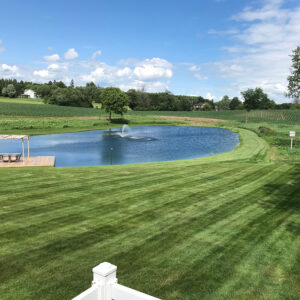Summer is long gone, and for many people, so are the days of admiring your manicured lawn and yard. It’s easy to neglect caring for your lawn once the cooler weather hits. Cozying up on the couch with a blanket to binge-watch a new Netflix series just seems more appealing. Or maybe you’re too busy apple-picking and pumpkin-patching. Whatever the case, you’ll have to come to terms with the fact that your lawn still needs some TLC.
Unfortunately, the leaves won’t rake themselves. It’s essential to care for your lawn year-round to maintain its health and growth. We’ve compiled some simple seasonal guidelines to ensure your property looks great year-round.
Simple Guidelines for Year-Round Lawncare
Fall
Taking proper care of your lawn in the fall ensures that it will survive the frigid temperatures of the winter. Prepare your lawn for winter by:
- Mowing: lawns still need the occasional cut, with the last one taking place in late fall. The final cut should be short so that you protect your lawn from mould and mildew when it’s covered in snow and ice. You can also shred some fallen leaves this way, saving your back from raking.
- Dethatching: if necessary, dethatch your lawn to avoid lawn diseases and infestations. A thatch problem results from new organic matter building up more quickly than older organic matter breaks down.
- Raking: make sure to rake all your leaves to allow sunlight to reach your lawn and avoid decomposing leaves causing insect infestations or suffocating your lawn.
- Aerating: aerate your lawn to break up compacted soil, which can choke roots and leave less room for air and water in the ground. Aerating will soften up your soil to allow for proper drainage, and your lawn can better absorb the nutrients from fall food (in the next step).
- Seeding and feeding: seed your entire lawn, especially the bare patches, in dry conditions. Make sure to sow the seed and water your lawn thoroughly. Feed the lawn with fall-specific food to toughen up your lawn for the winter months. The key ingredient to look for is potassium.
Winter
You can get back on the couch with your blanky for the winter. Your lawn needs much less attention since the grass is dormant. There are just a few pointers you can follow to prepare your grass for the spring:
- Remove any remaining leaves. There always seem to be little stragglers that miss the memo. Make sure to bag these babies to avoid any infestations or diseases.
- Aerate and fertilize before the first frost.
- Try to stay off the lawn in the winter to prevent damage, which is easier said than done if you have kids or dogs.
- During milder winter temps, feel free to dig up any areas you plan to lay turf in the spring.
Spring
Get an early start to lawn care in the spring to kickstart healthy growth. Your lawn needs it after those harsh winter months!
- Remove any leaves you may have missed, fallen debris, or garbage!
- Scarify: Lightly scarify or dethatch the layer of dead grass accumulated over the winter with a spring-tined rake or a mechanical scarifier.
- Aerate: aerate to break up compacted soil and allow for proper drainage with snow melts and rainfall.
- Layout turf and seed. Spring is a great time to layout your turf since the soil is more tenable. It’s also a great time to seed your lawn as there’s plenty of rain to support germination and establish a robust root system.
- Feeding: a spring feed is essential to restoring and providing nutrients. The critical ingredient this time is nitrogen, as it encourages vigorous growth. Try to time your feedings with rainfall, so that it gets properly absorbed into your lawn.
Summer
As the temperatures rise during the summer months, your grass will experience more stress and increased use. It will be essential to keep the lawn from drying out.
- Watering: watering your lawn during dry spells will help to keep it healthy. It’s imperative to regularly water new grass to ensure seeding success. To wet your lawn, you can use an irrigation system, a simple garden hose, or a sprinkler. An optimal time to water is early morning or in the evening to prevent evaporation.
- Weeding: keep up with your weeding so that your lawn doesn’t have to compete for nutrients, sunlight, and water. Make sure to remove the whole root when it comes to dandelions. Other weeds such as clovers, speedwell, and daisies can be sprayed (but avoid spraying during periods of drought).
- Mowing: mow your lawn once or twice a week, except during periods of drought. During dry periods, raise the cutting height to prevent the base of the lawn from getting scorched by the sun.
Hopefully, this condensed guideline will help you maintain your lawn throughout the year. If you’re looking beyond lawncare to add some more oomph to your backyard, our inspiration guide might spark a fire! Or you can get in touch with our landscape architects for a free consultation.
We would be happy to provide you with a quote in helping with your lawn looking perfect all year ’round.
GET A FREE CONSULTATION

Need inspiration?
When you start to think about designing the perfect yard, deck, patio or backyard oasis, it can be helpful to have some solid ideas of what you want to achieve. We can help with that.




